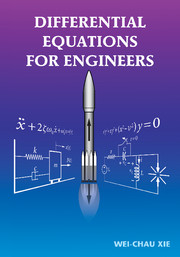Book contents
- Frontmatter
- Contents
- Preface
- 1 Introduction
- 2 First-Order and Simple Higher-Order Differential Equations
- 3 Applications of First-Order and Simple Higher-Order Equations
- 4 Linear Differential Equations
- 5 Applications of Linear Differential Equations
- 6 The Laplace Transform and Its Applications
- 7 Systems of Linear Differential Equations
- 8 Applications of Systems of Linear Differential Equations
- 9 Series Solutions of Differential Equations
- 10 Numerical Solutions of Differential Equations
- 11 Partial Differential Equations
- 12 Solving Ordinary Differential Equations Using Maple
- Appendix A Tables of Mathematical Formulas
- Index
8 - Applications of Systems of Linear Differential Equations
Published online by Cambridge University Press: 05 June 2012
- Frontmatter
- Contents
- Preface
- 1 Introduction
- 2 First-Order and Simple Higher-Order Differential Equations
- 3 Applications of First-Order and Simple Higher-Order Equations
- 4 Linear Differential Equations
- 5 Applications of Linear Differential Equations
- 6 The Laplace Transform and Its Applications
- 7 Systems of Linear Differential Equations
- 8 Applications of Systems of Linear Differential Equations
- 9 Series Solutions of Differential Equations
- 10 Numerical Solutions of Differential Equations
- 11 Partial Differential Equations
- 12 Solving Ordinary Differential Equations Using Maple
- Appendix A Tables of Mathematical Formulas
- Index
Summary
In this chapter, examples are presented to illustrate engineering applications of systems of linear differential equations.
Mathematical Modeling of Mechanical Vibrations
In many engineering applications, such as vibration of mechanical systems, the systems are usually complex and have to be modeled as multiple degrees-of-freedom systems, resulting in systems of linear ordinary differential equations. Modeling a complex engineering system as an appropriate, mathematically tractable problem and establishing the governing differential equations are often the first challenging step. In this section, a free vibration problem of a simple two degrees-of-freedom system is first considered to illustrated the basic procedure. The equations of motion of a more complex problem, i.e., the vibration of an automobile, which is modeled as a four degrees-of-freedom system, are then established.
Example 8.1 – Two Degrees-of-Freedom System
Two uniform rods AB and CD of mass density per unit length ρ are hinged at A and C. Rotational springs of stiffnesses κ1 and κ2 provide resistance to rotations of end A and end C, respectively, as shown. The lengths of AB and CD are L1 and L2, respectively. Rod AB carries a concentrated mass M at end B. The rods are connected by a spring of stiffness k. When the rods are hanging freely, they are vertical and there is no force in the spring.
- Type
- Chapter
- Information
- Differential Equations for Engineers , pp. 357 - 389Publisher: Cambridge University PressPrint publication year: 2010



